Brealey, Myers. Principles of Corporate Finance. 7th edition
Подождите немного. Документ загружается.

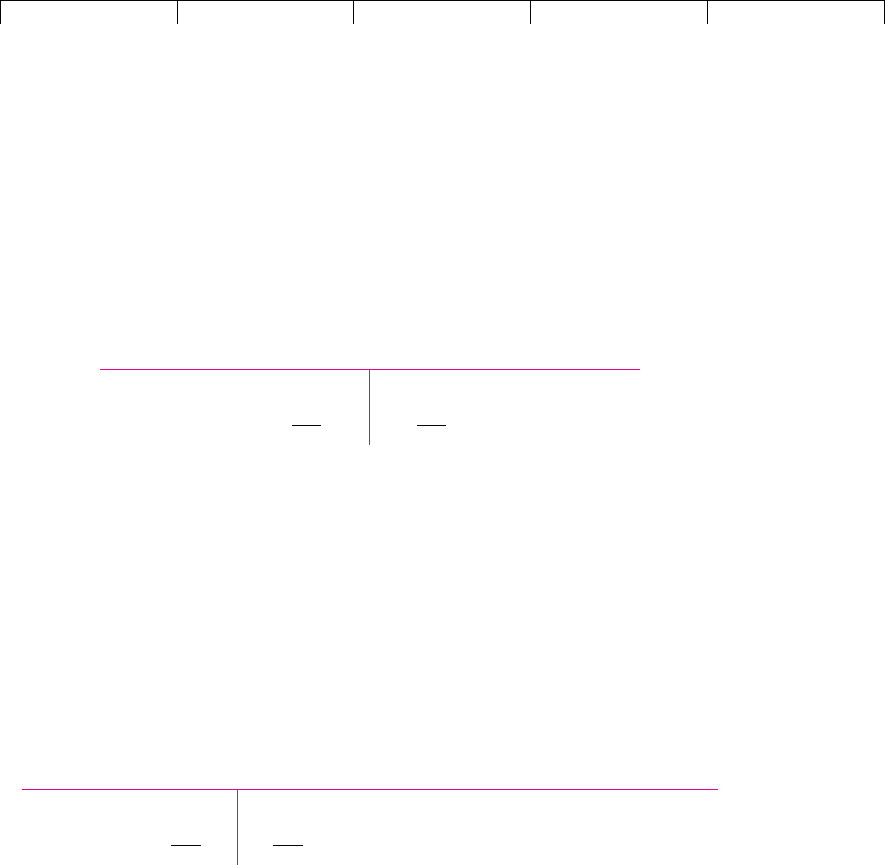
Brealey−Meyers:
Principles of Corporate
Finance, Seventh Edition
VI. Options 20. Understanding Options
© The McGraw−Hill
Companies, 2003
Default Puts and the Difference between Safe and Risky Bonds
In Chapter 18 we discussed the plight of Circular File Company, which borrowed
$50 per share. Unfortunately the firm fell on hard times and the market value of its
assets fell to $30. Circular’s bond and stock prices fell to $25 and $5, respectively.
Circular’s market value balance sheet is now
CHAPTER 20
Understanding Options 573
Circular File Company (Market Values)
Asset value $30 $25 Bonds
5 Stock
$30 $30 Firm value
If Circular’s debt were due and payable now, the firm could not repay the $50 it
originally borrowed. It would default, bondholders receiving assets worth $30 and
shareholders receiving nothing. The reason Circular stock is worth $5 is that the
debt is not due now but rather is due a year from now. A stroke of good fortune
could increase firm value enough to pay off the bondholders in full, with some-
thing left over for the stockholders.
Let us go back to a statement that we made at the start of the chapter. Whenever
a firm borrows, the lender effectively acquires the company and the shareholders ob-
tain the option to buy it back by paying off the debt. The stockholders have in effect
purchased a call option on the assets of the firm. The bondholders have sold them
this call option. Thus the balance sheet of Circular File can be expressed as follows:
Circular File Company (Market Values)
Asset value $30 $25
5
$30 $30 Firm value asset value
Stock value value of call
Bond value asset value value of call
If this still sounds like a strange idea to you, try drawing one of Bachelier’s po-
sition diagrams for Circular File. It should look like Figure 20.6. If the future value
of the assets is less than $50, Circular will default and the stock will be worthless.
If the value of the assets exceeds $50, the stockholders will receive asset value less
the $50 paid over to the bondholders. The payoffs in Figure 20.6 are identical to a
call option on the firm’s assets, with an exercise price of $50.
Now look again at the basic relationship between calls and puts:
To apply this to Circular File, we have to interpret “value of share” as “asset value,”
because the common stock is a call option on the firm’s assets. Also, “present value
of exercise price” is the present value of receiving the promised payment of $50 to
bondholders for sure next year. Thus
Now we can solve for the value of Circular’s bonds. This is equal to the firm’s
asset value less the value of the shareholders’ call option on these assets:
present value of promised payment to bondholders value of put
Bond value asset value value of call
value of put asset value
Value of call present value of promised payment to bondholders
Value of call present value of exercise price value of put value of share
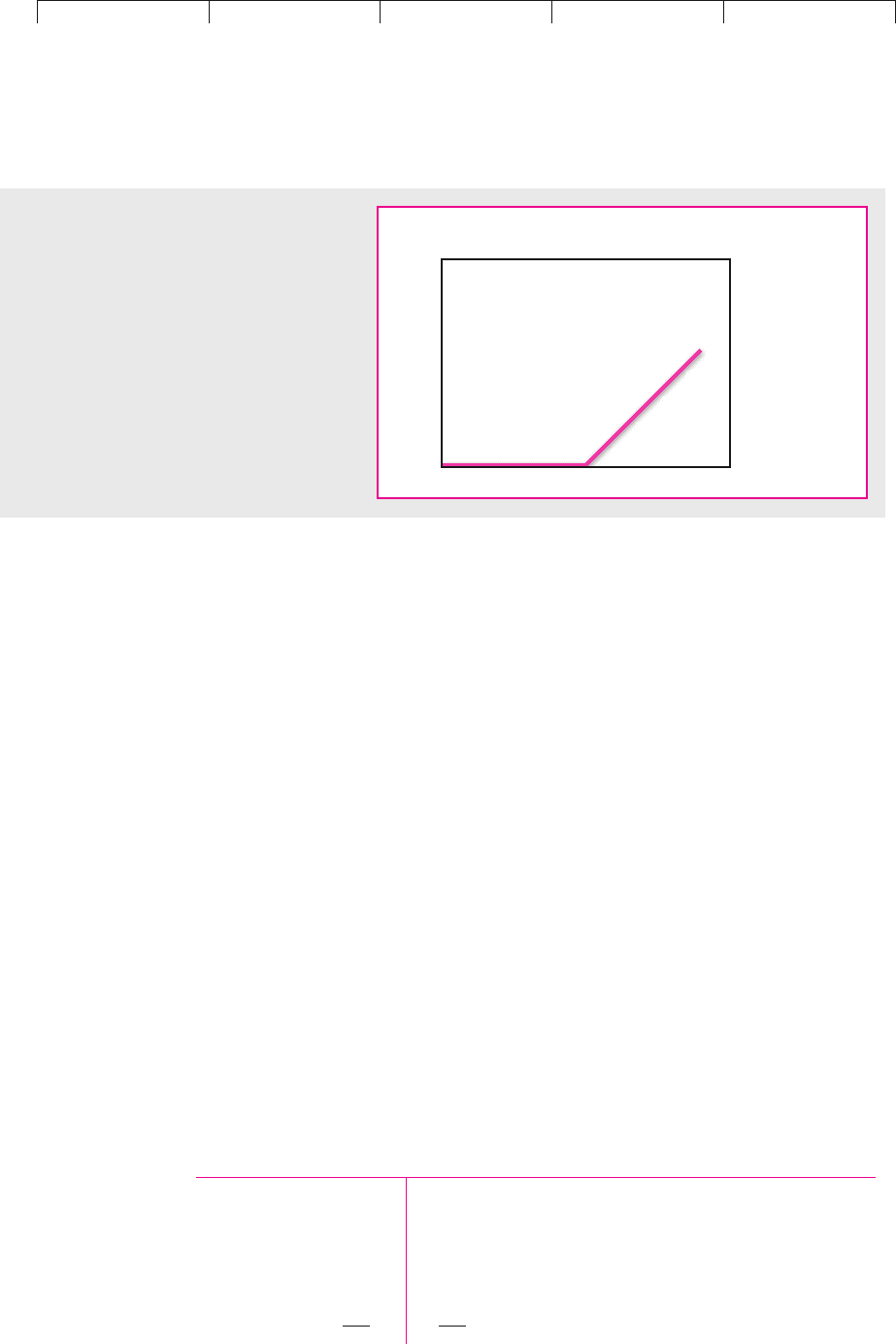
Brealey−Meyers:
Principles of Corporate
Finance, Seventh Edition
VI. Options 20. Understanding Options
© The McGraw−Hill
Companies, 2003
Circular’s bondholders have in effect (1) bought a safe bond and (2) given the
shareholders the option to sell them the firm’s assets for the amount of the debt.
You can think of the bondholders as receiving the $50 promised payment, but they
have given the shareholders the option to take the $50 back in exchange for the as-
sets of the company. If firm value turns out to be less than the $50 that is promised
to bondholders, the shareholders will exercise their put option.
Circular’s risky bond is equal to a safe bond less the value of the shareholders’
option to default. To value this risky bond we need to value a safe bond and then
subtract the value of the default option. The default option is equal to a put option
on the firm’s assets. Now you can see why bond traders, investors, and financial
managers refer to default puts.
In the case of Circular File the option to default is extremely valuable because
default is likely to occur. At the other extreme, the value of IBM’s option to default
is trivial compared to the value of IBM’s assets. Default on IBM bonds is possible
but extremely unlikely. Option traders would say that for Circular File the put op-
tion is “deep in the money” because today’s asset value ($30) is well below the ex-
ercise price ($50). For IBM the put option is far “out of the money” because the
value of IBM’s assets substantially exceeds the value of IBM’s debt.
We know that Circular’s stock is equivalent to a call option on the firm’s assets.
It is also equal to (1) owning the firm’s assets, (2) borrowing the present value of
$50 with the obligation to repay regardless of what happens, but also (3) buying a
put on the firm’s assets with an exercise price of $50.
We can sum up by presenting Circular’s balance sheet in terms of asset value,
put value, and the present value of a sure $50 payment:
574 PART VI
Options
$50
$0
Future value
of stock
Future value
of firm's assets
FIGURE 20.6
The value of Circular’s common stock is the
same as the value of a call option on the firm’s
assets with an exercise price of $50.
Circular File Company (Market Values)
Asset value $30 $25 Bond value present value of promised
payment value of
default put
5 Stock value asset value present
value of promised
payment value of put
$30 $30 Firm value asset value
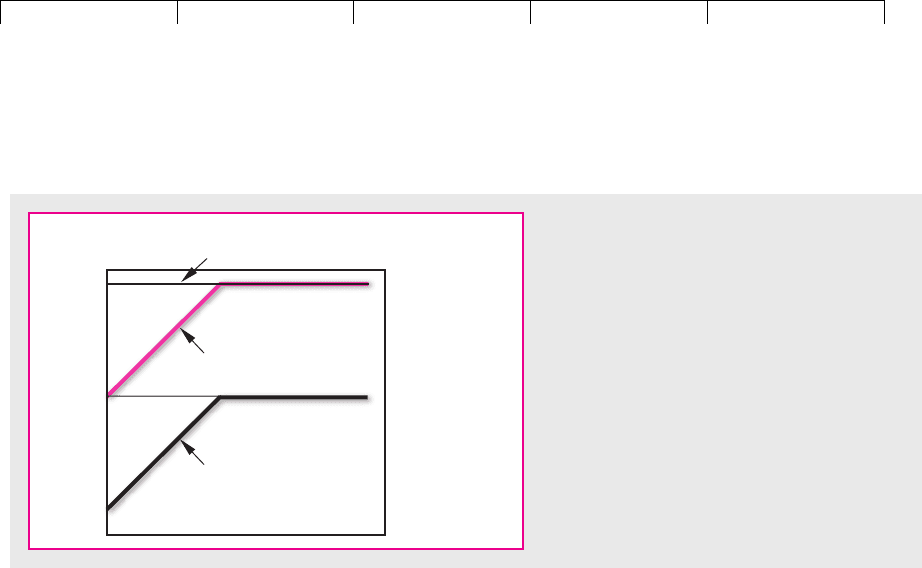
Brealey−Meyers:
Principles of Corporate
Finance, Seventh Edition
VI. Options 20. Understanding Options
© The McGraw−Hill
Companies, 2003
Again you can check this with a position diagram. The colored line in Figure 20.7
shows the payoffs to Circular’s bondholders. If the firm’s assets are worth more than
$50, the bondholders are paid off in full; if the assets are worth less than $50, the firm
defaults and the bondholders receive the value of the assets. You could get an iden-
tical payoff pattern by buying a safe bond (the upper black line) and selling a put op-
tion on the firm’s assets (the lower black line).
Spotting the Option
Options rarely come with a large label attached. Often the trickiest part of the prob-
lem is to identify the option. For example, we suspect that until it was pointed out,
you did not realize that every risky bond contains a hidden option. When you are
not sure whether you are dealing with a put or a call or a complicated blend of the
two, it is a good precaution to draw a position diagram. Here is an example.
The Flatiron and Mangle Corporation has offered its president, Ms. Higden,
the following incentive scheme: At the end of the year Ms. Higden will be paid
a bonus of $50,000 for every dollar that the price of Flatiron stock exceeds its cur-
rent figure of $120. However, the maximum bonus that she can receive is set at
$2 million.
You can think of Ms. Higden as owning 50,000 tickets, each of which pays noth-
ing if the stock price fails to beat $120. The value of each ticket then rises by $1 for
each dollar rise in the stock price up to the maximum of .
Figure 20.8 shows the payoffs from just one of these tickets. The payoffs are not the
same as those of the simple put and call options that we drew in Figure 20.2, but it
is possible to find a combination of options that exactly replicates Figure 20.8. Be-
fore going on to read the answer, see if you can spot it yourself. (If you are some-
one who enjoys puzzles of the make-a-triangle-from-just-two-match-sticks type,
this one should be a walkover.)
The answer is in Figure 20.9. The solid black line represents the purchase of a
call option with an exercise price of $120, and the dotted line shows the sale of an-
other call option with an exercise price of $160. The colored line shows the payoffs
from a combination of the purchase and the sale—exactly the same as the payoffs
from one of Ms. Higden’s tickets.
$2,000,000/50,000 $40
CHAPTER 20
Understanding Options 575
$50
$0
Future value
of bond/option
Risk-free bond
Future value
of firm's assets
Circular's bond
Put option,
payoff to seller
FIGURE 20.7
You can also think of Circular’s bond (the colored
line) as equivalent to a risk-free bond (the upper
black line) less a put option on the firm’s assets
with an exercise price of $50 (the lower black line).
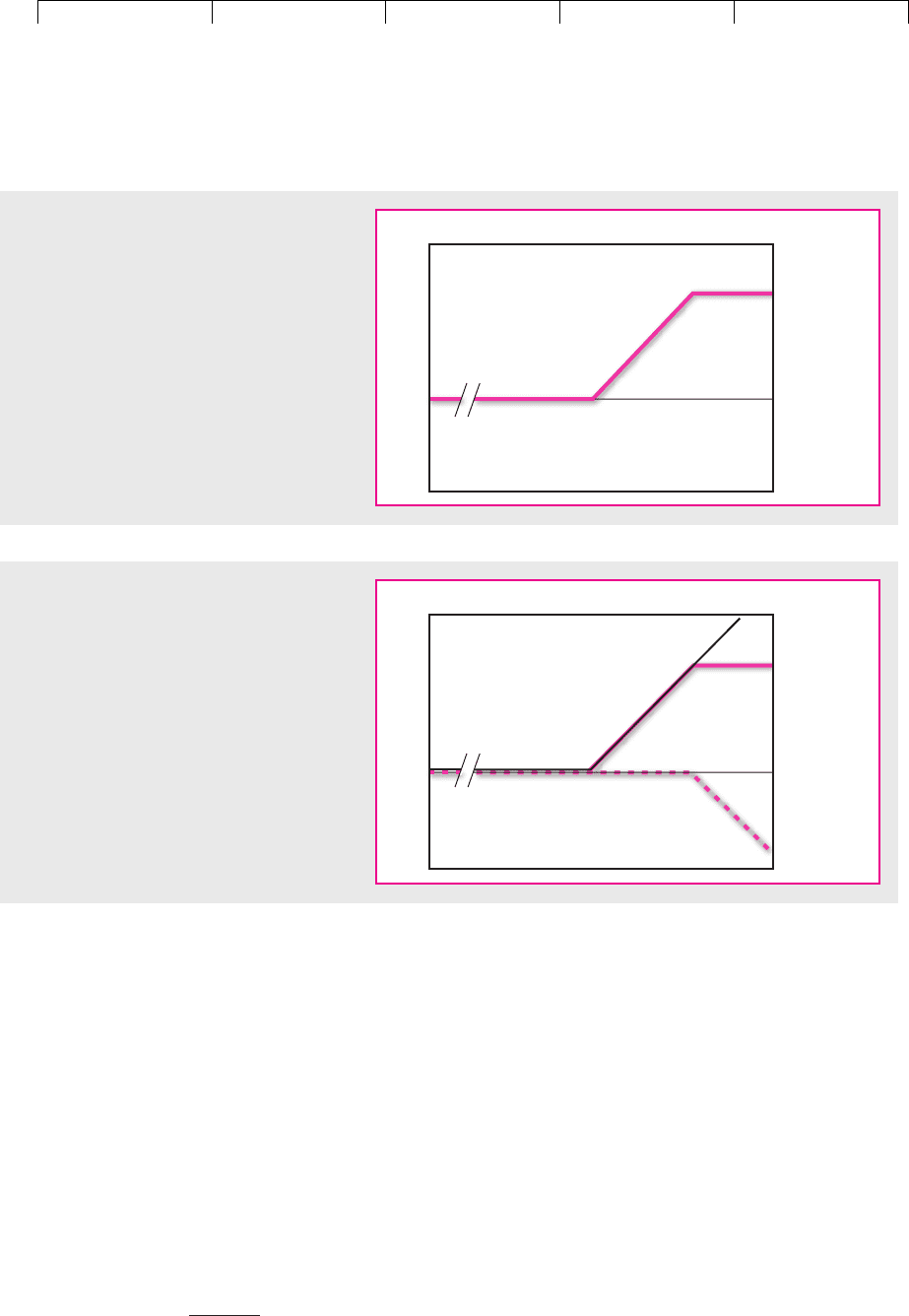
Brealey−Meyers:
Principles of Corporate
Finance, Seventh Edition
VI. Options 20. Understanding Options
© The McGraw−Hill
Companies, 2003
Thus, if we wish to know how much the incentive scheme is costing the company,
we need to calculate the difference between the value of 50,000 call options with an
exercise price of $120 and the value of 50,000 calls with an exercise price of $160.
We could have made the incentive scheme depend in a much more complicated
way on the stock price. For example, the bonus could peak at $2 million and then
fall steadily back to zero as the stock price climbs above $160. (Don’t ask why any-
one would want to offer such an arrangement—perhaps there’s some tax angle.)
You could still have represented this scheme as a combination of options. In fact,
we can state a general theorem:
Any set of contingent payoffs—that is, payoffs which depend on the value of some
other asset—can be constructed with a mixture of simple options on that asset.
In other words, you can create any position diagram—with as many ups and
downs or peaks and valleys as your imagination allows—by buying or selling the
right combinations of puts and calls with different exercise prices.
11
576 PART VI Options
$120 $160
$40
Payoff
Stock price
FIGURE 20.8
The payoff from one of Ms. Higden’s “tickets”
depends on Flatiron’s stock price.
$120
$160
$40
Payoff
Stock price
FIGURE 20.9
The solid black line shows the payoff from
buying a call with an exercise price of $120.
The dotted line shows the sale of a call with an
exercise price of $160. The combined purchase
and sale (shown by the colored line) is identical
to one of Ms. Higden’s “tickets.”
11
In some cases you may also have to borrow or lend money to generate a position diagram with your
desired pattern. Lending raises the payoff line in position diagrams, as in the bottom row of Figure 20.5.
Borrowing lowers the payoff line.
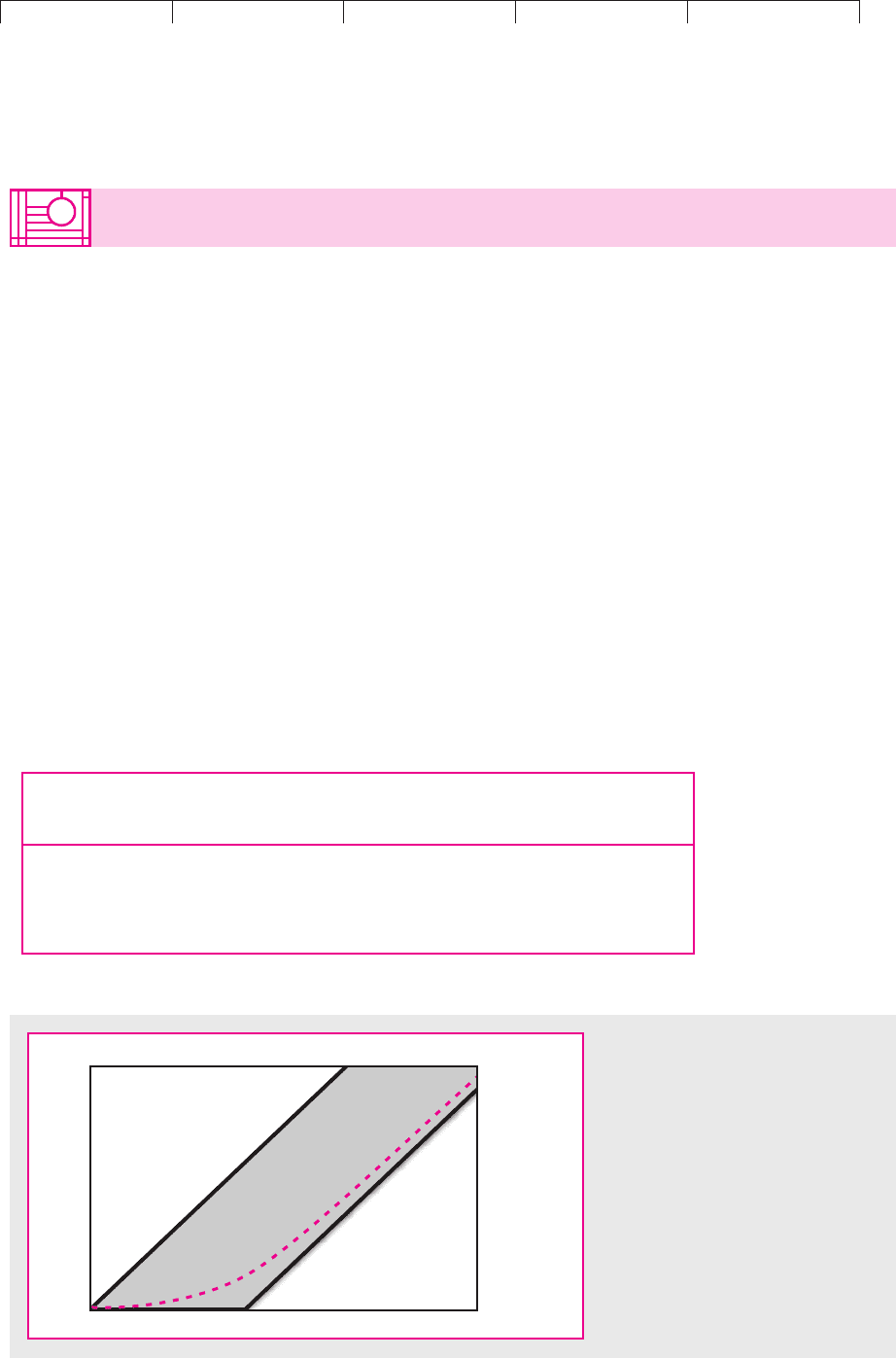
Brealey−Meyers:
Principles of Corporate
Finance, Seventh Edition
VI. Options 20. Understanding Options
© The McGraw−Hill
Companies, 2003
So far we have said nothing about how the market value of an option is determined.
We do know what an option is worth when it matures, however. Consider, for in-
stance, our earlier example of an option to buy AOL stock at $55. If AOL’s stock price
is below $55 on the exercise date, the call will be worthless; if the stock price is above
$55, the call will be worth $55 less than the value of the stock. In terms of Bachelier’s
position diagram, the relationship is depicted by the heavy, lower line in Figure 20.10.
Even before maturity the price of the option can never remain below the heavy,
lower-bound line in Figure 20.10. For example, if our option were priced at $5 and
the stock were priced at $70, it would pay any investor to sell the stock and then
buy it back by purchasing the option and exercising it for an additional $55. That
would give a money machine with a profit of $10. The demand for options from in-
vestors using the money machine would quickly force the option price up, at least
to the heavy line in the figure. For options that still have some time to run, the
heavy line is therefore a lower-bound limit on the market price of the option.
The diagonal line in Figure 20.10 is the upper-bound limit to the option price. Why?
Because the stock gives a higher ultimate payoff than the option. If at the option’s ex-
piration the stock price ends up above the exercise price, the option is worth the stock
price less the exercise price. If the stock price ends up below the exercise price, the op-
tion is worthless, but the stock’s owner still has a valuable security. Let P be the stock
price at the option’s expiration date, and assume the option’s exercise price is $55.
Then the extra dollar returns realized by stockholders are
CHAPTER 20
Understanding Options 577
20.3 WHAT DETERMINES OPTION VALUES?
Lower bound:
Value of call
equals payoff
if exercised
immediately
Upper bound:
Value of call
equals share
price
C
B
Value of call
Exercise price
Share price
A
FIGURE 20.10
Value of a call before its expiration
date (dashed line). The value depends
on the stock price. It is always worth
more than its value if exercised now
(heavy line). It is never worth more
than the stock price itself.
Extra Payoff
Stock Option from Holding Stock
Payoff Payoff Instead of Option
Option exercised
(P greater than $55) PP 55 $55
Option expires
unexercised (P less than or
equal to $55) P 0 P
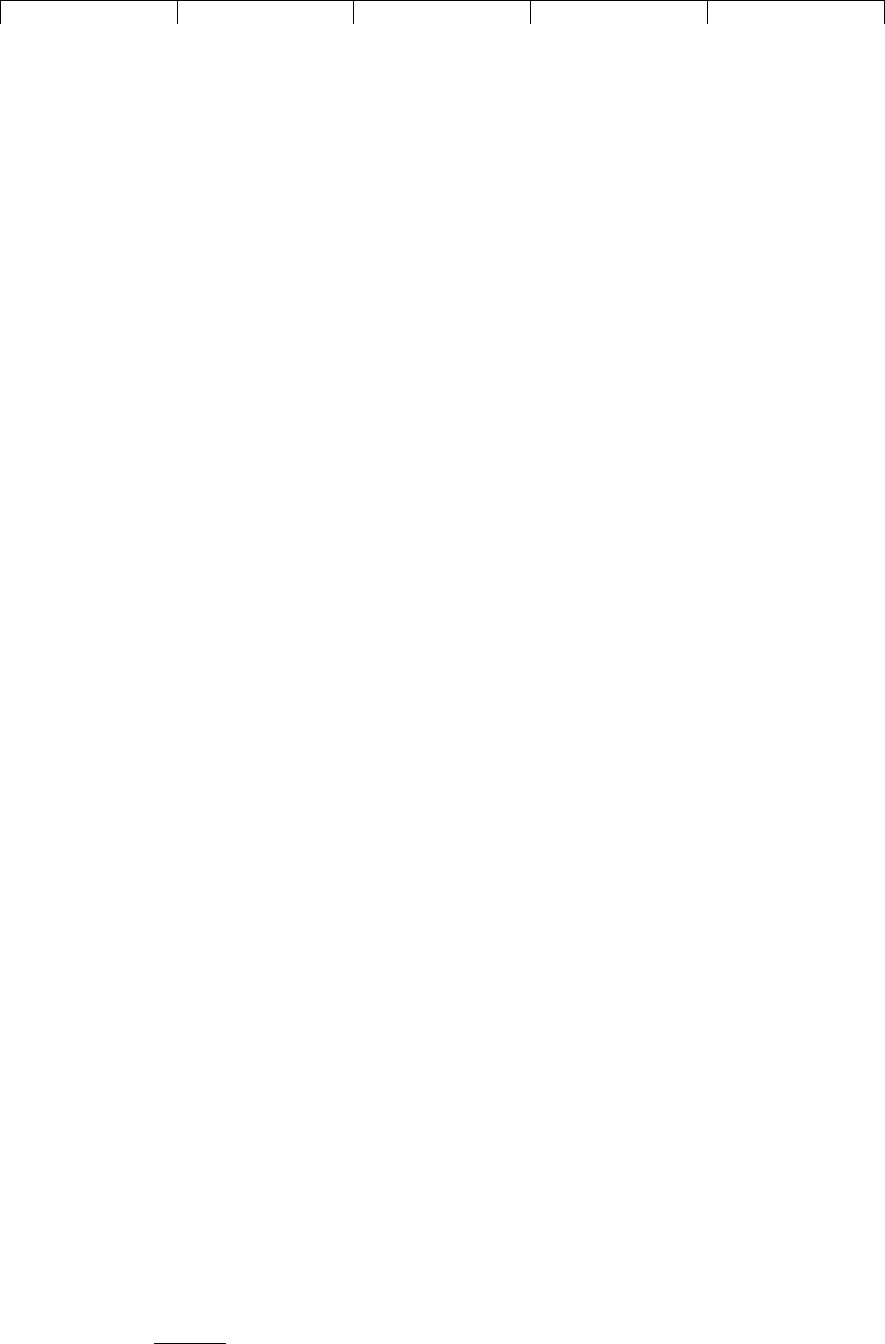
Brealey−Meyers:
Principles of Corporate
Finance, Seventh Edition
VI. Options 20. Understanding Options
© The McGraw−Hill
Companies, 2003
If the stock and the option have the same price, everyone will rush to sell the op-
tion and buy the stock. Therefore, the option price must be somewhere in the
shaded region of Figure 20.10. In fact, it will lie on a curved, upward-sloping line
like the dashed curve shown in the figure. This line begins its travels where the up-
per and lower bounds meet (at zero). Then it rises, gradually becoming parallel to
the upward-sloping part of the lower bound. This line tells us an important fact
about option values: The value of an option increases as stock price increases, if the ex-
ercise price is held constant.
That should be no surprise. Owners of call options clearly hope for the stock
price to rise and are happy when it does. But let us look more carefully at the shape
and location of the dashed line. Three points, A, B, and C, are marked on the dashed
line. As we explain each point you will see why the option price has to behave as
the dashed line predicts.
Point A When the stock is worthless, the option is worthless: A stock price of zero
means that there is no possibility the stock will ever have any future value.
12
If so,
the option is sure to expire unexercised and worthless, and it is worthless today.
Point B When the stock price becomes large, the option price approaches the stock price
less the present value of the exercise price: Notice that the dashed line representing the
option price in Figure 20.10 eventually becomes parallel to the ascending heavy
line representing the lower bound on the option price. The reason is as follows: The
higher the stock price is, the higher is the probability that the option will eventu-
ally be exercised. If the stock price is high enough, exercise becomes a virtual cer-
tainty; the probability that the stock price will fall below the exercise price before
the option expires becomes trivially small.
If you own an option that you know will be exchanged for a share of stock, you
effectively own the stock now. The only difference is that you don’t have to pay for
the stock (by handing over the exercise price) until later, when formal exercise oc-
curs. In these circumstances, buying the call is equivalent to buying the stock but
financing part of the purchase by borrowing. The amount implicitly borrowed is
the present value of the exercise price. The value of the call is therefore equal to the
stock price less the present value of the exercise price.
This brings us to another important point about options. Investors who acquire
stock by way of a call option are buying on credit. They pay the purchase price of
the option today, but they do not pay the exercise price until they actually take up
the option. The delay in payment is particularly valuable if interest rates are high
and the option has a long maturity. Thus, the value of an option increases with both the
rate of interest and the time to maturity.
Point C The option price always exceeds its minimum value (except when stock price
is zero): We have seen that the dashed and heavy lines in Figure 20.10 coincide
when stock price is zero (point A), but elsewhere the lines diverge; that is, the op-
tion price must exceed the minimum value given by the heavy line. The reason for
this can be understood by examining point C.
At point C, the stock price exactly equals the exercise price. The option is there-
fore worthless if exercised today. However, suppose that the option will not expire
578 PART VI
Options
12
If a stock can be worth something in the future, then investors will pay something for it today, although
possibly a very small amount.
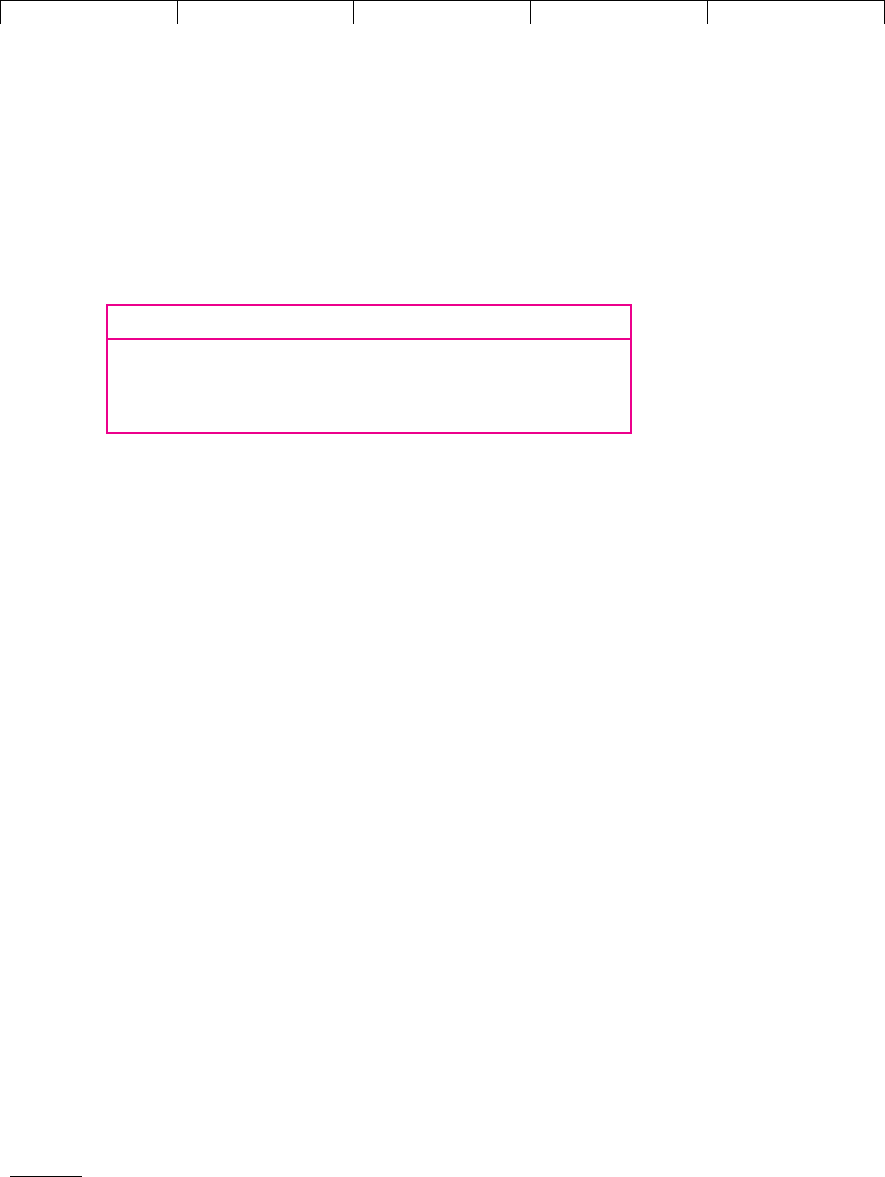
Brealey−Meyers:
Principles of Corporate
Finance, Seventh Edition
VI. Options 20. Understanding Options
© The McGraw−Hill
Companies, 2003
until three months hence. Of course we do not know what the stock price will be
at the expiration date. There is roughly a 50 percent chance that it will be higher
than the exercise price and a 50 percent chance that it will be lower. The possible
payoffs to the option are therefore
CHAPTER 20
Understanding Options 579
Outcome Payoff
Stock price rises Stock price less exercise price
(50 percent probability) (option is exercised)
Stock price falls Zero
(50 percent probability) (option expires worthless)
If there is a positive probability of a positive payoff, and if the worst payoff is zero,
then the option must be valuable. That means the option price at point C exceeds
its lower bound, which at point C is zero. In general, the option prices will exceed
their lower-bound values as long as there is time left before expiration.
One of the most important determinants of the height of the dashed curve (i.e.,
of the difference between actual and lower-bound value) is the likelihood of sub-
stantial movements in the stock price. An option on a stock whose price is unlikely
to change by more than 1 or 2 percent is not worth much; an option on a stock
whose price may halve or double is very valuable.
Panels (a) and (b) in Figure 20.11 illustrate this point. The panels compare the
payoffs at expiration of two options with the same exercise price and the same
stock price. The panels assume that stock price equals exercise price (like point C
in Figure 20.10), although this is not a necessary assumption.
13
The only difference
is that the price of stock Y at its option’s expiration date is much harder to predict
than the price of stock X at its option’s expiration date. You can see this from the
probability distributions superimposed on the figures.
In both cases there is roughly a 50 percent chance that the stock price will de-
cline and make the options worthless, but if the prices of stocks X and Y rise, the
odds are that Y will rise more than X. Thus there is a larger chance of a big payoff
from the option on Y. Since the chance of a zero payoff is the same, the option on Y
is worth more than the option on X. Figure 20.12 shows how the value of an option
increases as stock price volatility increases. The upper curved line shows the val-
ues of the AOL call option assuming that the stock price is highly variable. The
lower curved line assumes a lower (and more realistic) degree of volatility.
14
The probability of large stock price changes during the remaining life of an op-
tion depends on two things: (1) the variance (i.e., volatility) of the stock price per
period and (2) the number of periods until the option expires. If there are t remain-
ing periods, and the variance per period is , the value of the option should de-
pend on cumulative variability
t
.
15
Other things equal, you would like to hold
2
2
13
In drawing Figure 20.11 we have assumed that the distribution of possible stock prices is symmetric.
This also is not a necessary assumption, and we will look more carefully at the distribution of price
changes in the next chapter.
14
The option values shown in Figure 20.12 were calculated by using the Black–Scholes option-valuation
model. We explain this model in Chapter 21 and use it to value the AOL option.
15
Here is an intuitive explanation: If the stock price follows a random walk (see Section 13.2), succes-
sive price changes are statistically independent. The cumulative price change before expiration is the
sum of t random variables. The variance of a sum of independent random variables is the sum of the
variances of those variables. Thus, if is the variance of the daily price change, and there are t days un-
til expiration, the variance of the cumulative price change is .
2
t
2
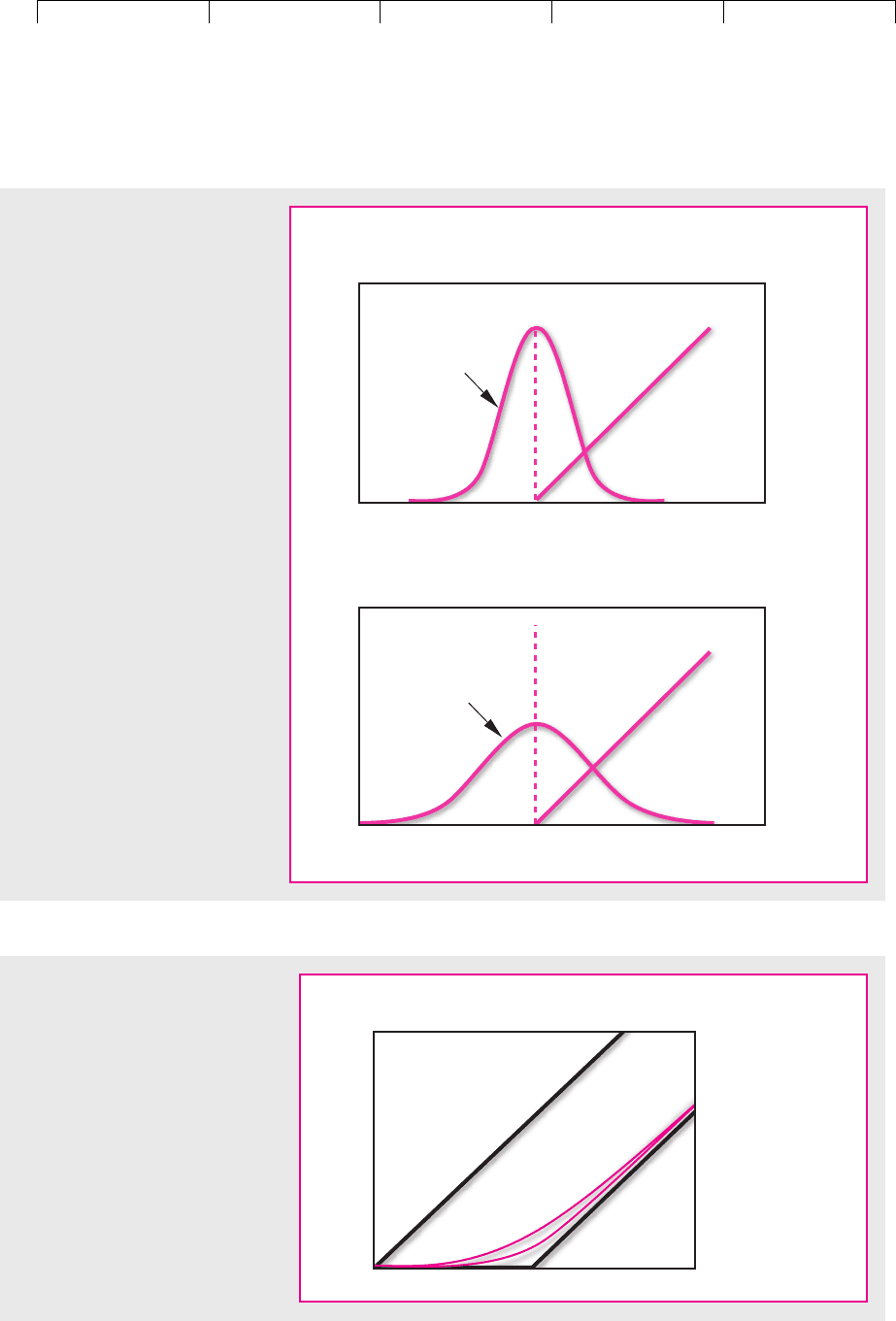
Brealey−Meyers:
Principles of Corporate
Finance, Seventh Edition
VI. Options 20. Understanding Options
© The McGraw−Hill
Companies, 2003
580 PART VI Options
Probability
distribution of
future price of
firm X's shares
Payoff to call
option on firm
X's shares
Payoff to
option on X
Firm X
share price
Exercise price
(
a
)
Probability
distribution of
future price of
firm Y's shares
Payoff to call
option on firm
Y's shares
Payoff to
option on Y
Firm Y
share price
Exercise price
(
b
)
FIGURE 20.11
Call options are written against the
shares of (a) firm X and (b) firm Y. In
each case, the current share price
equals the exercise price, so each
option has a 50 percent chance of
ending up worthless (if the share
price falls) and a 50 percent chance
of ending up “in the money” (if the
share price rises). However, the
chance of a large payoff is greater
for the option on firm Y’s share
because Y’s stock price is more
volatile and therefore has more
upside potential.
Values of
AOL call option
Lower
bound
Upper
bound
Exercise price = $55
Share price
FIGURE 20.12
How the value of the AOL call option
increases with the volatility of the
stock price. Each of the curved lines
shows the value of the option for
different initial stock prices. The only
difference is that the upper line
assumes a much higher level of
uncertainty about AOL’s future
stock price.
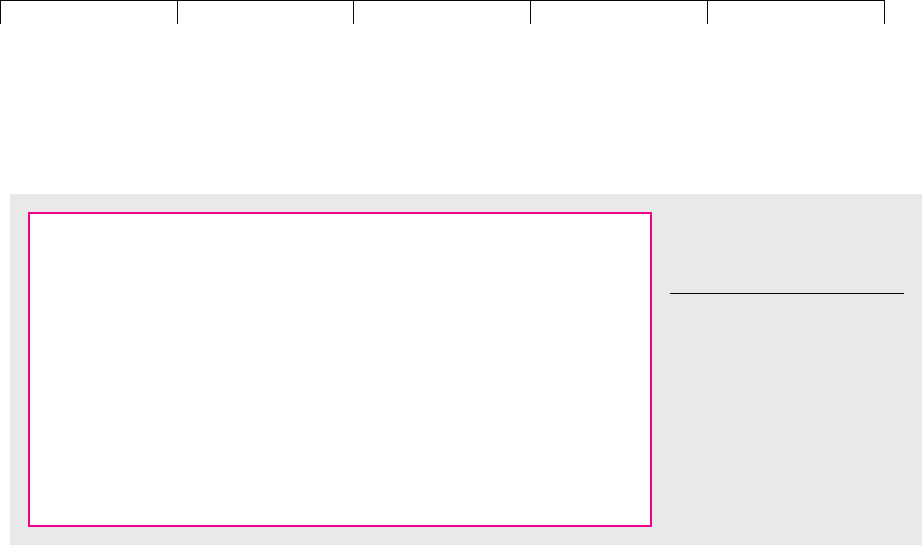
Brealey−Meyers:
Principles of Corporate
Finance, Seventh Edition
VI. Options 20. Understanding Options
© The McGraw−Hill
Companies, 2003
an option on a volatile stock (high ). Given volatility, you would like to hold an
option with a long life ahead of it (large t). Thus the value of an option increases
with both the volatility of the share price and the time to maturity.
It’s a rare person who can keep all these properties straight at first reading.
Therefore, we have summed them up in Table 20.2.
Risk and Option Values
In most financial settings, risk is a bad thing; you have to be paid to bear it. In-
vestors in risky (high-beta) stocks demand higher expected rates of return. High-
risk capital investment projects have correspondingly high costs of capital and
have to beat higher hurdle rates to achieve positive NPV.
For options it’s the other way around. As we have just seen, options written on
volatile assets are worth more than options written on safe assets. If you can un-
derstand and remember that one fact about options, you’ve come a long way.
Example. Suppose you have to choose between two job offers, as CFO of either
Establishment Industries or Digital Organics. Establishment Industries’ compen-
sation package includes a grant of the stock options described on the left side of
Table 20.3. You demand a similar package from Digital Organics, and they comply.
In fact they match the Establishment Industries options in every respect, as you can
see on the right side of Table 20.3. (The two companies’ current stock prices just
happen to be the same.) The only difference is that Digital Organics’ stock is half
again as volatile as Establishment Industries’ stock (36 percent annual standard de-
viation vs. 24 percent for Establishment Industries).
If your job choice hinges on the value of the executive stock options, you should
take the Digital Organics offer. The Digital Organics options are written on the
more volatile asset and therefore are worth more. We will value the two stock-
option packages in the next chapter.
Asset Risk and Equity Values In Section 18.3, we asserted that:
Financial managers who act strictly in their shareholders’ interests (and against the
interests of creditors) will favor risky projects over safe ones.
2
CHAPTER 20 Understanding Options 581
1. If there is an The change in the call
increase in: option price is:
Stock price (P) Positive
Exercise price (EX) Negative
Interest rate ( ) Positive
*
Time to expiration (t) Positive
Volatility of stock price ( ) Positive
*
2. Other properties:
a. Upper bound. The option price is always less than the stock price.
b. Lower bound. The option price never falls below the payoff to
immediate exercise ( or zero, whichever is larger).
c. If the stock is worthless, the option is worthless.
d. As the stock price becomes very large, the option price approaches the
stock price less the present value of the exercise price.
P EX
r
f
TABLE 20.2
What the price of a call option
depends on.
*The direct effects of increases in
on option price are positive.
There may also be indirect effects.
For example, an increase in could
reduce stock price P. This in turn
could reduce option price.
r
f
r
f
or
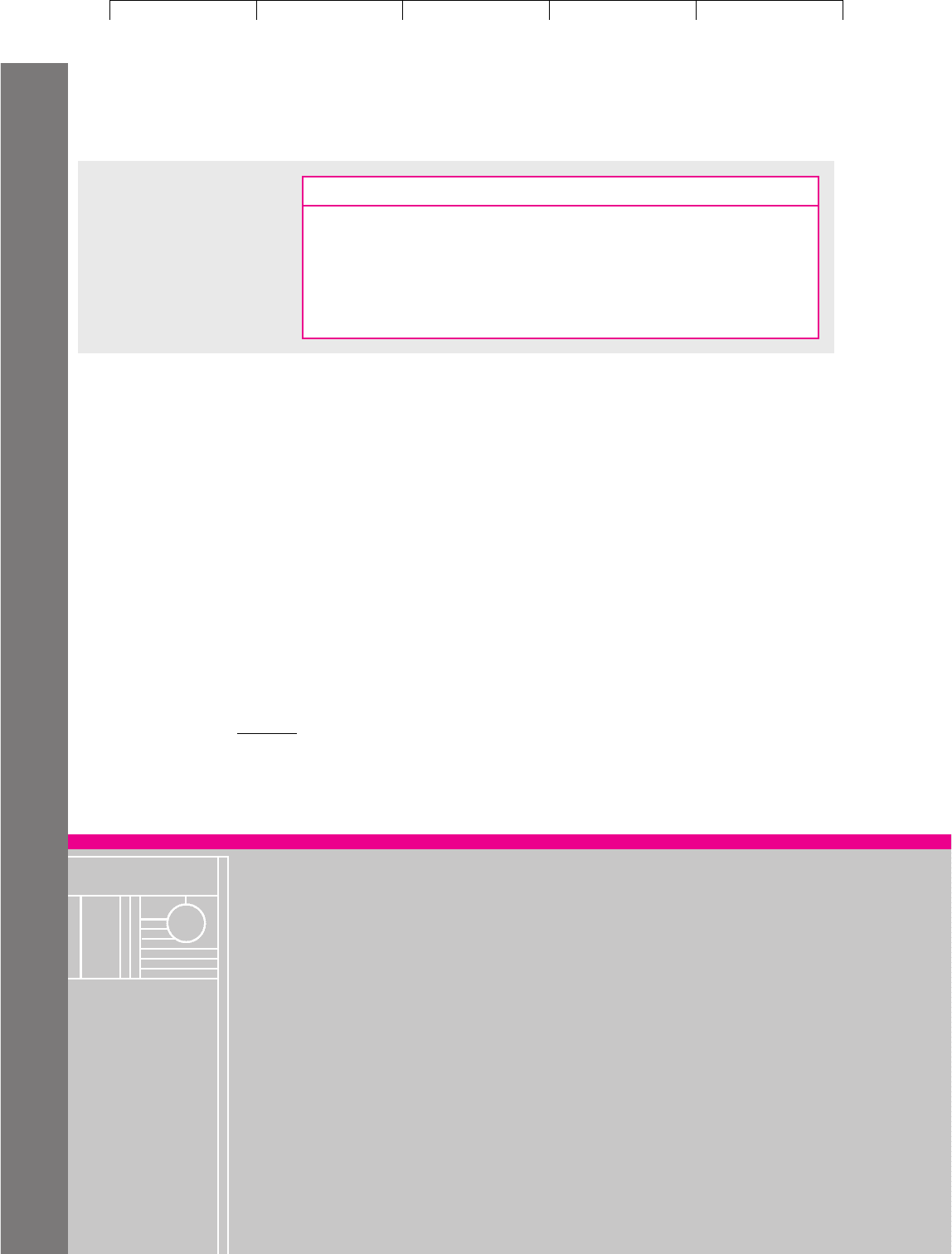
Brealey−Meyers:
Principles of Corporate
Finance, Seventh Edition
VI. Options 20. Understanding Options
© The McGraw−Hill
Companies, 2003
582 PART VI Options
Now you can see why this statement is generally true. Common stock is a call op-
tion written on the firm’s assets, and like all call options, its value depends on the
risk of the underlying asset. If the financial manager can swap a risky asset for
a safe one—holding everything else, including the value of the firm’s assets,
constant—then the value of the firm’s common stock increases and shareholders
are better off.
16
There is, of course, an offsetting decrease in the value of the firm’s debt. The
debtholders have given up a default put. The riskier the firm’s assets, the more that
put is worth. Since the put value is subtracted from the default-free value of the
debt, increased risk makes the debtholders worse off.
Although the assertion from Chapter 18 is generally true, it is not important for
established, blue-chip companies where the odds of default are miniscule. For ex-
ample, the value of the default put on Exxon Mobil’s debt is trivial. But there are
always companies, even large companies, in financial distress. Financial distress
means that the odds of default are not trivial, that the default put is valuable, and
that increased asset risk benefits shareholders.
16
In this context, risk means all sources of uncertainty, not just market risk. Option prices depend on the
standard deviation or variance of returns, not just on beta. You’ll see this more explicitly in the next
chapter.
Establishment Industries Digital Organics
Number of options 100,000 100,000
Exercise price $25 $25
Maturity 5 years 5 years
Current stock price $22 $22
Stock price volatility
(standard deviation
of return) 24% 36%
TABLE 20.3
Which package of executive
stock options would you
choose? The package offered
by Digital Organics is more
valuable, because the volatility
of that company’s stock is
higher.
SUMMARY
If you have managed to reach this point, you are probably in need of a rest and a
stiff gin and tonic. So we will summarize what we have learned so far and take up
the subject of options again in the next chapter when you are rested (or drunk).
There are two types of option. An American call is an option to buy an asset at
a specified exercise price on or before a specified exercise date. Similarly, an Amer-
ican put is an option to sell the asset at a specified price on or before a specified
date. European calls and puts are exactly the same except that they cannot be ex-
ercised before the specified exercise date. Calls and puts are the basic building
blocks that can be combined to give any pattern of payoffs.
What determines the value of a call option? Common sense tells us that it ought
to depend on three things:
1. To exercise an option you have to pay the exercise price. Other things being
equal, the less you are obliged to pay, the better. Therefore, the value of an op-
tion increases with the ratio of the asset price to the exercise price.
Visit us at www.mhhe.com/bm7e
